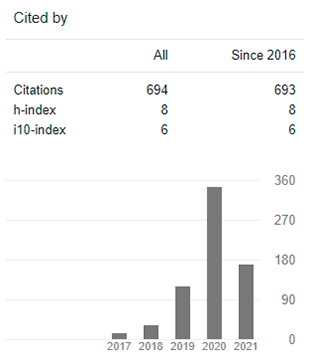Higher Education in Ecuador in relation to the Inclusion of People with Disabilities
DOI:
https://doi.org/10.29394/Scientific.issn.2542-2987.2022.7.24.20.375-387Keywords:
higher education, inclusive education, EcuadorAbstract
Reducing exclusion is a proposed goal within the framework of international regulations, in which governments and organizations come together to face it and in which Higher Education worldwide is working. The statistics regarding university students inserted in universities are not very encouraging, in Ecuador we have that only 1.29% of the population with disabilities according to the National Council for the Equality of Disabilities (CONADIS, 2020), are participating in this formation. Pedagogical praxis lacks training in education for the care of students with Specific Educational Needs, making this a determining factor in providing appropriate care. In Ecuador, the budget for higher education has decreased, which does not allow guaranteeing quality in inclusive processes, these resources must be managed by responding to the various edges and gearing attention to SEN (Deas and Bravo 2020). Considering the path traveled, it is imperative that the national governing level of higher education in Ecuador establish protocols that regulate and promote care for the university population with disabilities, regulations that are based on established public policies and that are applied. in all universities.
Downloads
References
CACES (2019). Modelo de Evaluación Externa de Universidades y Escuelas Politécnicas 2019. Quito, Ecuador: Consejo de Aseguramiento de la Calidad de la Educación Superior.
CONADIS (2020a,b). Estadísticas de Discapacidad. Ecuador: Consejo Nacional para la Igualdad de Discapacidades.
Deas, J., y Bravo, L. (2020). El financiamiento a la educación superior en el contexto de las políticas públicas en Ecuador. Cofin Habana, 14(1), 1-12. e-ISSN: 2073-6061. Cuba: Editorial UH.
Gómez, L. (2020). El presupuesto de las universidades, ¿dinero bien gastado?. Quito, Ecuador: Observatorio de Gasto Público.
LOD (2012). Ley Orgánica de Discapacidades. Registro Oficial Año IV - Nº 796. Quito, Ecuador: Asamblea Nacional del Ecuador.
LOES (2018). Ley Orgánica de Educación Superior. Quito: Registro Oficial Suplemento 298 de 12-oct.-2010. Ultima modificación: 02-ago.-2018. Ecuador: Presidencia de la República.
Ocampo, J. (2018). Discapacidad, Inclusión y Educación Superior en Ecuador: El Caso de la Universidad Católica de Santiago de Guayaquil. Revista latinoamericana de educación inclusiva, 12(2), 97-114, e-ISSN: 0718-7378. Recuperado de: https://doi.org/10.4067/s0718-73782018000200097
Plancarte, P. (2017). Inclusión educativa y cultura inclusiva. Revista de Educación Inclusiva, 10(2), 213-226. e-ISSN: 1989-4643. Recuperado de: https://revistaeducacioninclusiva.es/index.php/REI/article/view/294
Rojas-Avilés, H., Sandoval-Guerrero, L., & Borja-Ramos, O. (2020). Percepciones a una educación inclusiva en el Ecuador. Cátedra, 3(1), 75-93, e-ISSN: 2631-2875. Recuperado de: https://doi.org/10.29166/catedra.v3i1.1903
SENESCYT (2021). Acuerdo No. SENESCYT-2021-038. Ecuador: Secretaría de Educación Superior, Ciencia, Tecnología e Innovación.
Triviño-Sabando, J., Vera-García, L., Briones-Palacios, Y., & Triviño-Sabando, B. (2021). Inclusión de estudiantes con discapacidad en la universidad. Polo del Conocimiento, 6(5), 317-330, e-ISSN: 2550-682X. Ecuador: Imprenta y Casa Editora “Coni”.
UNESCO (2008). La Educación Inclusiva: El Camino Hacia el Futuro. Presentación General de la 48ª Reunión de la CIE. Ginebra, Suiza: Organización de las Naciones Unidas para la Educación, la Ciencia y la Cultura.
Downloads
Published
How to Cite
Issue
Section
License
Copyright (c) 2022 INDTEC, C.A.

This work is licensed under a Creative Commons Attribution-NonCommercial-ShareAlike 4.0 International License.
The content of the journals of this site, are under a Creative Commons Attribution-Noncommercial-Share Alike 4.0 International License.













